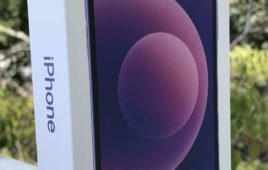$50 with two-year contract from AT&T
When the Pantech Discover was first announced by AT&T, one of the first comments I saw online was “That Pantech logo is disgusting.” A brutally honest first reaction, that sentiment seems in line with the general attitude toward Pantech as a maker of cheap, forgettable entry-level smartphones.
But the Korean handset company’s new mid-range LTE smartphone comes much more equipped than most starter phones have any right to be. In fact, its impressive specs are on par with the Samsung Galaxy SIII, one of the U.S. market’s favorite top-tier smartphones. The Discover packs the same 4.8-inch 720p display plus a rippin’ 1.5 GHz dual-core Snapdragon processor, an impressive 12.8 MP camera that shoots 1080p video, 1GB of RAM and 16GB of storage, which is expandable. And yet it’s $50 with a two-year contract ($400 up-front), same as the comparable HTC One VX and the Sony Xperia TL.
Yet there are many real factors—beside the “disgusting” logo—that keep the Discover from being a real deterrent to high-end smartphones’ dominance of the market, instead relegating it to the “very good but not great” corner with so many other worthy handsets.
Hardware
At first, the black, inset mesh speakers on both sides near the top of the phone are an attractive part of the design, if not another place for dirt and dust to accumulate. They accent the rubberized quilted pattern applied to the back of the phone, which is home to a center-mounted lens and flash, a pinhole for a mic, a few logos and nothing else. That in turn echoes the front, which features a minimal bezel on the rounded-edge glass screen, small speaker grid up top and no physical buttons.
But once those speakers are turned up full blast with the asymmetrical volume rocker, they’re practically loud enough to shake the pocket lint out of the headphone jack on top and the Micro USB port at the bottom.
Everything combines at just under five ounces in a relatively slim form that feels even more so due to the concave back. It’s easy to hold and operate one-handed, easy on the eyes—even if the display doesn’t do very well at an angle—and definitely easy to hear.
Software
The Discover comes running Android 4.0 (Ice Cream Sandwich) and Pantech’s custom skin on top, a combo that makes it friendly and easy to use if not exactly up-to-date. The old
version of Android is unlikely to win over any phone freaks, but it’s likely a factor in keeping the price down. Pantech has made some tweaks, like a customized unlock screen (which is easily changed), but the most significant change to the UI comes when you switch the phone over to “Easy Experience” mode.
The Easy Experience takes most (if all) challenge out of operating the phone, remolding it as a big-buttoned feature phone on a touchscreen, with emphasis put on the basic functions and a simple shortcut menu for the rest. It also recasts the unlock screen as a large, goofy light switch with lighted arrows pointing upward.
Most users will likely opt for the standard experience, but this feature is a great set of water wings for anyone just getting their feet wet in the smartphone pool.
The home screen has plenty of options for customization above the on-screen navigation buttons, with an app dock that can hold up to 14 icons by letting the user slide it to the left and  to the right. That kind of out-front storage space will help prevent having to dive into the apps menu filled with bloatware.
to the right. That kind of out-front storage space will help prevent having to dive into the apps menu filled with bloatware.
The keyboard feels slightly clunky and missing your key can be easy, but the predictive text boxes at the top are helpful. The inverted number pad for the second panel feels strange at first, until you just think of it like a dialer.
Beyond the useful stuff, the Discover packs some novelty tricks like motion recognition. Used for changing tracks in the music player, flipping through images in the gallery or answering calls, it’s fun to play with. But you have to get used to making a circular motion with your hand to avoid crossing the sensor in reverse and just alternating between the same photos or songs.
Camera
The camera can be launched within the platform or through the lock screen and it takes about two seconds to fire up. Once up and running, it takes a little less than a second to snap a shot. Images shot in daylight generally look great while pictures taken in low light don’t so much, with a tendency to wash out colors. But the in-camera editing options tend to help quite a bit with getting the photos to where you want them.
The 1080p video looks crisp and the camera does a fairly good job of maintaining focus. The sound performed just as well and microphone overachieved, easily picking up sound far off from the subject.
Performance
The processor handled all my daily use, gliding smoothly through the platform and swapping in and out of apps quickly with very little lag. The radio did well outside but coverage suffered indoors. Call quality was fine in all instances with only minor disruptions. The battery, which can be accessed along with the SIM and memory cards by pulling off the back panel, performed about as well as most comparable handsets. A full charge in the morning made it to about 6 p.m. with usage varying from moderate to heavy. And I’ll say once more that the stereo speakers are a welcome and full-sounding alternative to the back- or bottom-mounted tinny sound experience to which most mobile users are accustomed.
Verdict
The Discover by itself won’t reinvent Pantech overnight and there are still flaws like an outdated OS—though the company told PC Mag Jelly Bean is coming—that will prevent it from really having a wide impact. But it’s a terrific entry-level phone that looks and feels like a flagship more often, showing off impressive muscle and thoughtful construction.




